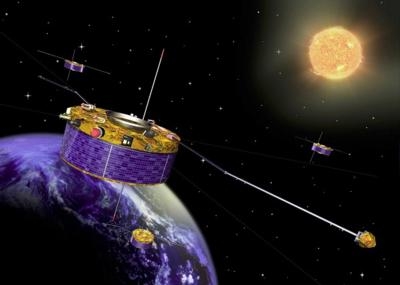Mon, Sep 30, 2013
Four Identical Spacecraft Have Been Studying The Earth's Magnetospehere In Three Dimensions
Since 2000, the four identical satellites of the Cluster quartet have been probing Earth’s magnetosphere in three dimensions. This week, two of them made their closest-ever approach, just two-and-a-half miles, enabling valuable data to be acquired with unprecedented detail.

In an orbital reconfiguration that will help to maintain the mission’s life span, two of the four satellites achieved their closest-ever separation on 19 September, closing to within just 2.5 miles of each other as they orbited at up to 14,000 mph high above Earth. “We’re optimizing the Cluster formation so that the separation between Cluster 1 and the duo of Cluster 3 and 4 – which are on almost identical orbits – is kept below 62 miles when the formation crosses Earth’s magnetic equator,” says Detlef Sieg, working on Cluster flight dynamics at ESA’s ESOC operations centre in Darmstadt, Germany.
The formation will hold three of the four satellites close together at lower altitudes, optimizing the range of science observations. “Following the closest-ever approach on 30 August, we achieved a new mission record with C1 and C3 (September 19), at just 4 km (2.4 miles) around 0912 GMT,” says Juergen Volpp, Spacecraft Operations Manager at ESOC.
The main challenge in achieving the formation was to exclude any collision risk and to avoid further maneuvres, which would interrupt science activities. “We can determine the satellites’ orbits with an accuracy better than 0.1 km (328 feet),” says Detlef Sieg, “so we knew we could achieve the formation with sufficient allowance for safety.”
The new formation will be held until early November before the separations are increased to more than 621 miles. “When we started Cluster, we believed that a separation of 500 km 310 miles) was the smallest required by science,” says ESA’s Phillipe Escoubet, Cluster Mission Scientist. “However, it turns out that the physical processes at very small scales are very important and this is why we have decided to decrease the separation distance to more than a factor 100 to just 4 km (2.4 miles), as it will allow us to study electromagnetic waves in the radiation belts with unprecedented detail.”
(Image provided by ESA)
More News
Light Gun A handheld directional light signaling device which emits a brilliant narrow beam of white, green, or red light as selected by the tower controller. The color and type of>[...]
"The journey to this achievement started nearly a decade ago when a freshly commissioned Gentry, driven by a fascination with new technologies and a desire to contribute significan>[...]
Aero Linx: JAARS, Inc. For decades now, we’ve landed planes on narrow rivers and towering mountains. We’ve outfitted boats and vehicles to reach villages that rarely se>[...]
"Our driven and innovative team of military and civilian Airmen delivers combat power daily, ensuring our nation is ready today and tomorrow." Source: General Duke Richardson, AFMC>[...]
Aircraft Conflict Predicted conflict, within EDST of two aircraft, or between aircraft and airspace. A Red alert is used for conflicts when the predicted minimum separation is 5 na>[...]
 ANN's Daily Aero-Term (04.20.24): Light Gun
ANN's Daily Aero-Term (04.20.24): Light Gun Aero-News: Quote of the Day (04.20.24)
Aero-News: Quote of the Day (04.20.24) ANN's Daily Aero-Linx (04.21.24)
ANN's Daily Aero-Linx (04.21.24) Aero-News: Quote of the Day (04.21.24)
Aero-News: Quote of the Day (04.21.24) ANN's Daily Aero-Term (04.21.24): Aircraft Conflict
ANN's Daily Aero-Term (04.21.24): Aircraft Conflict



